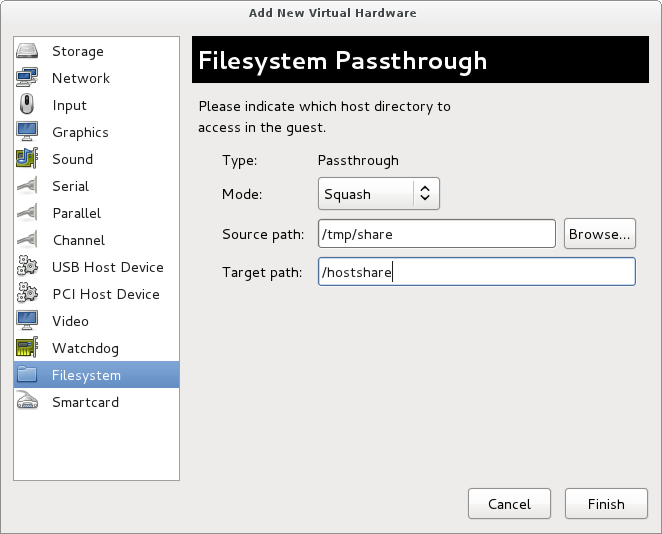Example Sharing Host files with the Guest — 9p — qemu-kvm
http://www.linux-kvm.org/page/9p_virtio
Example Sharing Host files with the Guest
This example is based on qemu-kvm (0.15.0) as installed in Fedora 15.Will first show how to do this manually, and second how to do it using the virt-manager tool. This HOWTO is documenting 9p virtio as the transport for sharing files.
In both cases we'll share files in /tmp/share on the host. In the guest, they'll show up in /tmp/host_files.
Manually, using qemu-kvm command line
There are a nice set of details on the QEMU wiki describing this, so this section will be quite short. To share host files w/ the guest, we use 9p over virtio in conjunction w/ a filesystem device exporting the portion of the host filesystem that we'd like to share with the guest.
# /usr/bin/qemu-kvm -m 1024 -name f15 -drive file=/images/f15.img,if=virtio -fsdev local,security_model=passthrough,id=fsdev0,path=/tmp/share -device virtio-9p-pci,id=fs0,fsdev=fsdev0,mount_tag=hostshare
This tells qemu to create a 9pvirtio device exposing the mount_tag hostshare (just a name to identify the mount point). That device is coupled to an fsdev named
fsdev0, which specifies which portion of the host filesystem we are sharing, and in which mode (see
QEMU wiki for details on the security models).
Now, in the guest we need to mount the 9p filesystem from the host using the virtio transport. The mount_tag is used to identify the host's share.
# mkdir /tmp/host_files # mount -t 9p -o trans=virtio,version=9p2000.L hostshare /tmp/host_files
That's it...now we can read/write files in that directory from either the host or the guest.
Managed, using virt-manager
This assumes you've already installed a guest with virt-manager or virt-install and it's shut off.
Start virt-manager, and open your VM by double clicking on it. Click the virtual hardware details (lightbulb). Click Add Hardware, and choose a Filesystem. Chose the mode, we chose squash which translates to none (see QEMU wiki for details on the security models), the source (we are sharing /tmp/share), and the target (we called this /hostshare).
Now, start the VM. In the guest we need to mount the 9p filesystem from the host using the virtio transport. The mount_tag is used to identify the host's share.
# mkdir /tmp/host_files # mount -t 9p -o trans=virtio,version=9p2000.L /hostshare /tmp/host_files
That's it...now we can read/write files in that directory from either the host or the guest. (Note: likely to hit some issues w/ privileges since Fedora libvirt runs guests unprivileged and with SELinux confinement...careful use of chown, chmod and chcon should get it working).






【推荐】国内首个AI IDE,深度理解中文开发场景,立即下载体验Trae
【推荐】编程新体验,更懂你的AI,立即体验豆包MarsCode编程助手
【推荐】抖音旗下AI助手豆包,你的智能百科全书,全免费不限次数
【推荐】轻量又高性能的 SSH 工具 IShell:AI 加持,快人一步
· 基于Microsoft.Extensions.AI核心库实现RAG应用
· Linux系列:如何用heaptrack跟踪.NET程序的非托管内存泄露
· 开发者必知的日志记录最佳实践
· SQL Server 2025 AI相关能力初探
· Linux系列:如何用 C#调用 C方法造成内存泄露
· 无需6万激活码!GitHub神秘组织3小时极速复刻Manus,手把手教你使用OpenManus搭建本
· Manus爆火,是硬核还是营销?
· 终于写完轮子一部分:tcp代理 了,记录一下
· 别再用vector<bool>了!Google高级工程师:这可能是STL最大的设计失误
· 单元测试从入门到精通